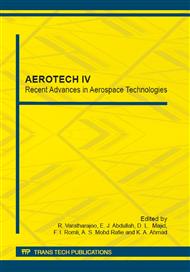p.103
p.109
p.121
p.127
p.132
p.138
p.144
p.150
p.158
Modal Properties of a Cantilevered Laminated Woven Composite Plate as Affected by Stacking Sequence and Fiber Orientation: An Experimental Study
Abstract:
The use of laminated composites in aircraft structures is not totally new. However, the idea of using woven fiber glass as reinforcement in primary structural members is not widely addressed as compared to unidirectional fibers. In an effort to characterize the dynamic behavior of a woven laminated composite subject to dynamic loads, modal testing is performed experimentally on a cantilevered laminated woven glass fiber/epoxy composite flat plate which resembles an aircraft wing with aspect ratio of 5. To that end, the effect of stacking sequence and fiber orientation of the laminated composite plate on the modal properties is assessed. 6-layer laminated composite configurations with various stacking sequence and fiber orientation are fabricated so as to generate variable stiffness plates. The modal test employs the single roving hammer technique to obtain the frequency response of the plate and the results of the first five modes against the fiber orientation and stacking sequence are analyzed.
Info:
Periodical:
Pages:
132-137
Citation:
Online since:
November 2012
Price:
Сopyright:
© 2012 Trans Tech Publications Ltd. All Rights Reserved
Share:
Citation:


